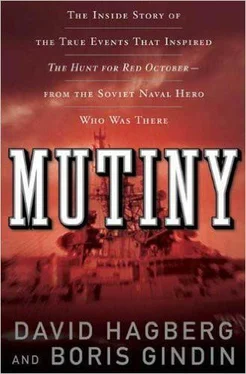It’s another gun barrel Gindin is looking down as Sablin waits for the officers to make their decisions. In the blink of an eye Gindin can not only see his career going by the wayside, he can also practically see and feel and taste the past seven years as if they were happening at this instant. Especially when the Storozhevoy was being built.
18. BUILDING THE STOROZHEVOY
It takes two years to build a warship that size. The Storozhevoy’s keel is laid down at the boatyard called Yantar Zavod 820 in Kaliningrad, which is a little less than fifty kilometers farther up the inlet from his eventual home port of Baltiysk, in 1972, and the ship is finished in early 1974.
Boris joins the building crew about five months before the ship is ready for sea. At that time they have a different zampolit, a pinch-faced little man who does everything strictly by the book and never cracks a smile. He’d transferred from a submarine and shortly after Boris arrives is transferred to still another ship. His replacement is Sablin, who is like a breath of fresh air by comparison.
Sablin is approachable, friendly, cracks jokes, even smiles. But he is the zampolit, and he believes in the Party line and does his job well, so the officers and sailors must still attend political indoctrination classes, but somehow with Sablin the mumbo jumbo isn’t quite as boring. Things start to look up.
The officers and crew lived in housing outside of Kaliningrad, about twenty minutes by tram from the shipyards and thirty from downtown.
It wasn’t a very large area, and it was protected by a tall fence. Guards were stationed around the clock at the front gate, and anyone wanting to get inside had to show his papers. In the middle of the compound was a three-story redbrick building that housed all two hundred of the officers and men, plus some classrooms where everyone took their political training, just like aboard ship.
The place was something like a cross between the ship and a military jail, although there was a small general store where you could buy a few things if you had the money. Canned food, candy, cookies, milk, cigarettes. The store also sold navy uniforms and insignia, so everyone was expected to look his best at all times. They had a basketball court to use in their spare time, whenever there was spare time, and a park where they could relax.
Captain Potulniy, his zampolit, and his starpom, the three senior officers, had rooms of their own. The other officers all bunked in the same room, and the rest of the crew lived in one big cubrick.
When a ship was built in the yard, his crew was assembled from throughout the fleet and was housed in this compound until it was time to move aboard. Then, when the next ship started construction, the new crew would take over the redbrick building until it was their time to move aboard their ship.
Gindin’s typical routine during these months was morning exercise and breakfast, political training, and then down to the ship with the sailors in his section. There he would continue their training while overseeing the installation of his gas turbines, diesels, and other mechanical equipment. They ate lunch at the compound and then in the afternoon would return from the ship for more training and dinner.
Gindin was off duty the evening of every third day, which meant he could take the tram into the city and perhaps see a movie or eat at a nice restaurant. In his estimation Kaliningrad wasn’t much of a city, plain and a little drab compared to his hometown of Pushkin with its trees and flowers and parks and palaces, but it was better than the compound.
The shipyard, which was also surrounded by a fence and patrolled by guards, was like a small city of long one-story buildings, called cekhs, in which were produced the equipment and parts that went into building a warship.
Hundreds of machinists, welders, lathe operators, and engineers worked around the clock, six days per week. The pace always seemed alive, even frantic, and very messy, with noise and smoke. The entire shipyard smelled like a combination of seawater, oil, gasoline, paint, and rancid grease, but inside each cekh the overriding smell almost always seemed to be that of sweat.
Building a ship was a long, hot, very hard job, done by men and women, who in those days weren’t very keen on bathing regularly. Nor did Moscow care. Ships needed to be produced as fast as humanly possible to defend against the enemies of the Soviet Union.
Inventory depots of spare parts that had been manufactured elsewhere were contained in two- and three-story buildings scattered throughout the shipyard. And there were two buildings, both of them three stories tall, that housed the medical staff, a complete dispensary, and a hospital. Building ships at the pace Moscow wanted them built was not only a difficult business; it was also a risky business.
Railroad sidings crisscrossed the entire yard where not only warships were being constructed but also civilian ships such as tankers and transport ships of every kind were built or repaired. Six long piers stretched out to deep water at Yantar Zavod, and each could accommodate two or three ships at the same time.
The shipyard was a busy place.
“I was very excited to be doing my job,” Gindin recalls. “To me it was one of the most prestigious jobs an officer could have. I was part of a great experience. I was part of not only building the Storozhevoy from the keel up; I was on the first crew that would take him to sea.
“We were giving birth to our ship. We had a feeling of pride, excitement, contentment, and a sense of accomplishment.”
Even after the mutiny and its consequences, Gindin will consider these months at Yantar Zavod the most satisfying, gratifying times of his life. A period, in fact, that he would live over again without a moment’s hesitation. Powerful stuff for a kid in his early twenties. A Russian Jew from Pushkin.
Finally it’s time for the officers and sailors to move from the compound to the ship. They’ll be living aboard, even as work is still being done, but now just about everyone is happy and in good spirits. They are the crew who are building this ship, and they are the crew who are the first to sleep and eat and work in the compartments, and they are the crew who will take him to sea for his trials, and they are the crew who will sail on his first rotation.
Painting still needs to be finished, and trim work needs to be completed, though on Soviet warships there is very little of that sort of nonutilitarian nonsense. Adjustments need to be made on every single system aboard; that includes all the electrical wiring and equipment, all the weapons systems, all the electronics, all the plumbing and fuel tanks and piping, and the four main gas turbine engines as well as the small diesel engines that provide electrical power. The cabins and galleys and mess halls and cubricks and the bridge all need finishing. When that’s done, the ship is sailed to his base at Baltisk where the missiles and mines and ammunition for the guns need to be loaded aboard so that during sea trials all the weapons systems can be tested.
It’s this mix of civilian shipbuilders and navy crew aboard at the same time, working around the clock to finish the ship and take him to sea, that creates some moments of frustration but other moments of sometimes black humor.
Nikolai Lisenko, who is the civilian manager for all the painting jobs on the Storozhevoy, needs Boris’s signature certifying that work done in the machinery spaces has been finished to strict military specifications.
Fifteen huge fuel tanks hold 175,000 gallons of diesel oil low in the hull, divided port and starboard. They supply the fuel for the four big gas turbines and for the diesel auxiliary engines. Gas turbines and diesel engines do not run if the fuel is dirty. That means that the insides of the big tanks need to be painted thoroughly. No spot can be missed, and that includes dozens of small connectors, valves, and piping through which the fuel is distributed.
Читать дальше












